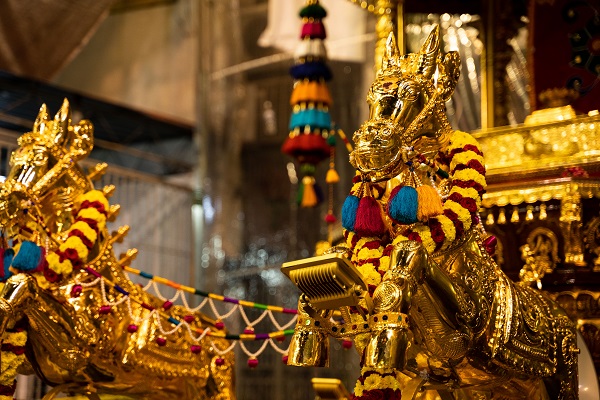
Penang Thaipusam is a three-day celebration that sees devotees clad in yellow and saffron, bearing milk pots on their heads or kavadis with body and facial piercings, seeking blessings, fulfilling vows and offering thanks to Lord Murugan.
The Thaipusam tradition was brought to Penang through the South Indian diaspora during the late 18th century. Thanks to Penang’s diversity and multiculturalism, the Hindu festival has since taken on an identity of its own. Here are some unmissable Penang Thaipusam experiences for your travel bucket list.

From UNESCO heritage site to the fringe of a virgin rainforest
Far more than kavadis and body piercings, Penang Thaipusam takes you through Penang’s diverse cultural and natural heritage, starting at Little India in the heart of the UNESCO heritage site and ending at the fringe of a virgin rainforest.
The Penang Thaipusam procession begins in the wee hours of the morning at the Sri Mahamariamman Temple – Penang’s oldest Hindu temple – in Lebuh Queen and the Kovil Veedu in Lebuh Penang. The procession then passes pre-war shophouses along Lebuh Queen, Lebuh Chulia, Lebuh Victoria, before entering Jalan Magazine to Jalan Datuk Keramat, Jalan Utama and Jalan Kebun Bunga, where the Arulmigu Sri Balathandayuthapani Waterfall Hilltop Temple is located. Upon reaching the foothill, devotees must climb over 500 steps to reach the Arulmigu Sri Balathandayuthapani Waterfall Hilltop Temple – that’s 272 steps more than the famous Batu Caves!
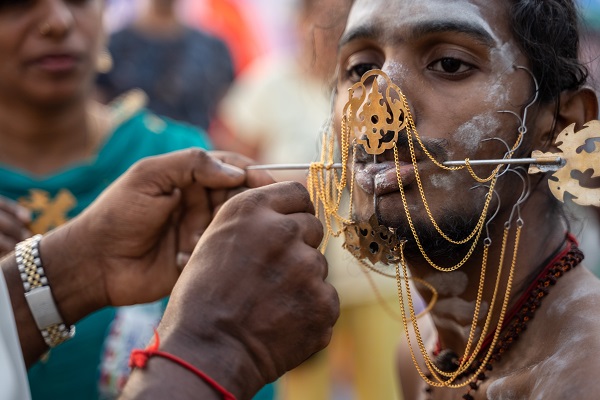
Along the journey, devotees and visitors will pass by notable Hindu temples in Penang such as the Sri Muthu Mariamman Temple at Lorong Kulit and the Shree Muniswarar Temple at Jalan Kebun Bunga. Those who are keen to witness the piercing ritual can do so over at these temples. “The best time to observe the ritual is on the eve of Thaipusam at night or on Thaipusam day from morning until evening,” says Penang Hindu Endowment Board (PHEB) secretary R. Surentharan.
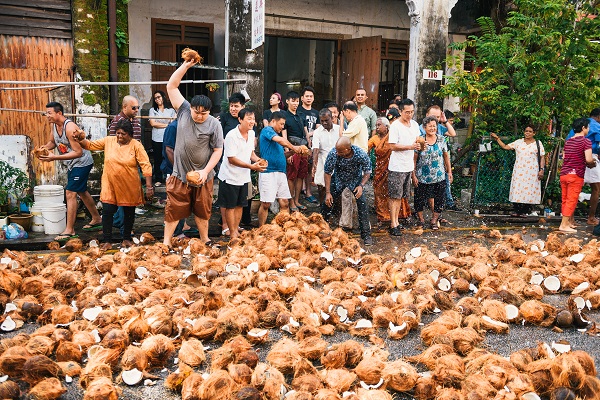
Cross-Cultural Celebration
Thaipusam celebration in Penang is not only celebrated by the Indians but also participated by other races, notably the Chinese. Ethnic Chinese kavadi bearers often turn heads at Penang Thaipusam celebration.
Celebrated annually in January or February, Thaipusam often coincides with Chinese New Year celebration, so it’s common to hear Chinese firecrackers amidst the drummings that accompany kavadi bearers. If you’re lucky, you could watch lion dance performers blessing the Chinese-owned shops nearby the procession route.
You’ll also see Chinese devotees approaching the chariots with offerings. Huge piles of coconuts bearing small placards with the names of local Chinese-owned businesses and how many coconuts they readied can be spotted along the procession route.
“When I first came to Penang, it was a cultural shift to see the amount of Chinese devotees offering prayers and breaking coconuts along the procession route. I have been to Batu Caves and Ipoh Thaipusam but more Chinese devotees are seen in Penang Thaipusam. It’s truly unique,” says Sujata Velappa, a Penang-based devotee from Selangor.
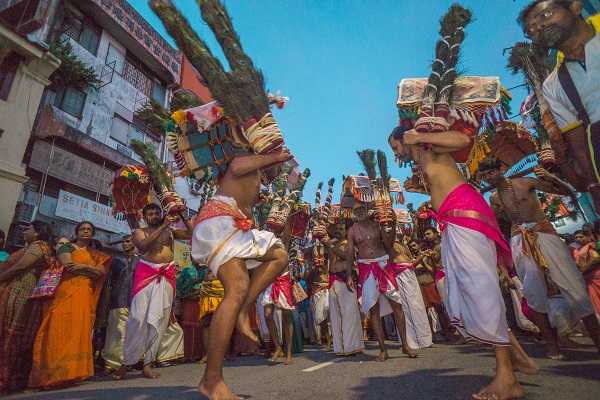
The Chetti Pusam
Penang Thaipusam is truly a little more unique than the rest. On the eve of Thaipusam, devotees from the Penang Chettiar community take the kavadis on a procession from the Nagarathar Sivan Temple at Jalan Dato Keramat to the Nattukottai Chettiar Temple in Jalan Kebun Bunga. Known as the Chetti Pusam, this procession is unusual as the Chettiar Indians carry peacock kavadis and they avoid body piercing and other pain-defying rituals.
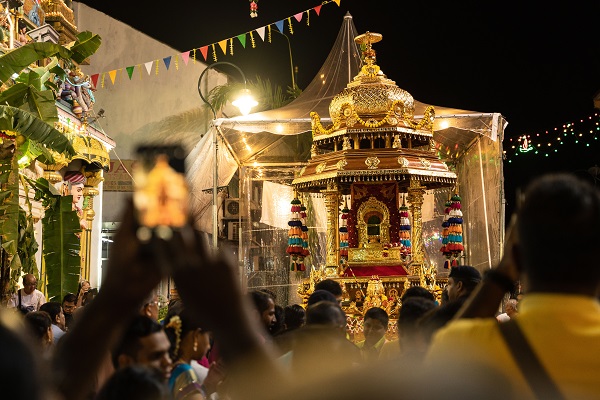
The Silver and Golden Chariots
Unlike other Thaipusam celebrations in other states, Penang Thaipusam features two chariots – instead of one silver chariot – since 2017, breaking a 164-year tradition. The silver chariot carries the statue of Lord Murugan while the golden chariot carries the vel (spear).
Although starting and ending at different temples, the chariots share the same 6.6 kilometres procession route which takes more than half a day to complete. The golden chariot departs from the Sri Mahamariamman Temple in Lebuh Queen at 6am and arrives at the Arulmigu Sri Ganeshar Temple in Jalan Kebun Bunga. Meanwhile, the silver chariot departs from the Kovil Veedu Temple in Lebuh Penang at 7am and arrives at the Nattukotai Chettiar Temple in Jalan Kebun Bunga.
Festival-like Atmosphere
Vibrant, colourful and lively, Thaipusam is celebrated with much festivity in Penang. Devotees can be seen chanting vel, vel, vetri (victorious) or Vel, Vel Muruga (Glory unto Muruga). Nearby, traditional drummers beating on urumi melams (hour-glassed shaped drums), thavils (barrel-shaped drum), jaalras (clash cymbals) and thappus (round drums) accompany devotees as they fulfil their vows. Rhythmic dancing and devotional music can be seen and heard throughout the procession route.
You can find beautifully decorated thanneer panthals (refreshment stalls) serving up free drinks and traditional Indian vegetarian dishes to the public throughout the festival along Jalan Utama and Jalan Kebun Bunga. Local vendors will also set up stalls selling traditional Indian goods, souvenirs, decorative items and various snacks and refreshments so you can do a little browsing amidst the festivities.